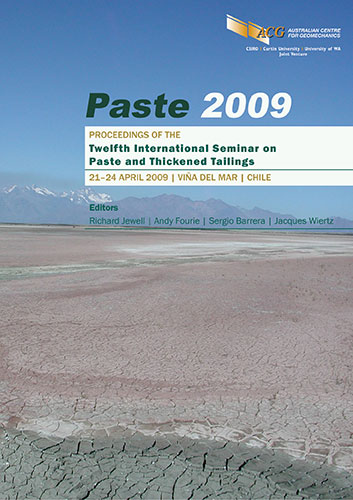Performance of Composite Paste Barricades at Goldcorp Inc., Red Lake Mine, Ontario, Canada

|
Authors: Hughes, PB; Pakalnis, R; Hitch, M; Corey, G |
DOI https://doi.org/10.36487/ACG_repo/963_36
Cite As:
Hughes, PB, Pakalnis, R, Hitch, M & Corey, G 2009, 'Performance of Composite Paste Barricades at Goldcorp Inc., Red Lake Mine, Ontario, Canada', in R Jewell, AB Fourie, S Barrera & J Wiertz (eds), Paste 2009: Proceedings of the Twelfth International Seminar on Paste and Thickened Tailings, Australian Centre for Geomechanics, Perth, pp. 325-335, https://doi.org/10.36487/ACG_repo/963_36
Abstract:
Appropriate strength barricades and fill fences are a necessary component of underhand cut and fill mining operations and stoping operation in general. These important structures are subject to a number of stresses and strains as a result of the deposition, and curing of the backfill material. Parametric monitoring of fill fences gives the engineer the required data to predict not only the behaviour of the paste backfill as it is being deposited but also the ability to predict the deformation and eventual failure of the barricade. A study was undertaken to determine the performance of the paste barricades at Goldcorp Inc.’s Red Lake Mine using real time instrumentation to monitor the stresses, strains and deformation of paste and paste barricades during placement. The barricades at the mine are a standardised barricade comprised of 10 cm of shotcrete applied to a rebar skeleton spaced nominally 60 cm apart. In total eight fill barricades were instrumented to determine the behaviour of the paste during the loading. Complementing the eight barricade tests, an instrumented destructive test was carried out to determine the ultimate capacity of the composite barricade. It was determined that the paste backfill behaves as a Rankine-like soil in the initial stages of placement with an average coefficient of lateral earth pressure, Ka, of 0.56. The destructive test determined that the yielding stress of a paste barricade is approximately 100 kPa. The results of the investigation have resulted in operational changes in the placement of paste at the mine.
References:
Dehn, K.K., Pakalnis, R. and Corey, G. (2007) Determining fill fence stability during increased backfill rates at an
underground hard rock mine. Proceedings of MINEFILL 2007. Montreal, Quebec.
Golder Associates Ltd (2000) Paste backfill plant - operational manual. Report prepared for Goldcorp Ltd. Red Lake
Mine. Report 991–9934.
Mah, P., Tessier, M. and Clelland, J. (2003) Mining methods at Goldcorp’s Red Lake mine. Proceedings of the 2003,
16th CIM Mine Operators Conference. Oct 19–22, 2003. Saskatoon, Saskatchewan.
Marcinyshyn, K., Pakalnis, R., Dunbar, S. and Vongpasial, S. (1997) Sill mat design. Proceedings of the 1999, CIM
Annual General Meeting. May 1999. Edmonton, Alberta.
Mitchell, R.J., Smith, J.D. and Libby, D.J. (1975) Bulkhead pressures due to cemented hydraulic backfills. Canadian
Geotechnical Journal, 12.
Mott, R. (2002) Applied strength of materials. Ontario: Prentice Hall.
Revell, M.B. and Sainsbury, D.P. (2007) Paste bulkhead failures. Proceedings of MINEFILL 2007. Montreal, Quebec.
Terzaghi, K., Peck, R. and Mesri, G. (1996) Soil mechanics in Engineering Practice, Third Edition, John Wiley and
Sons Inc.: New York.
Twomey, T. and McGibbon, S. (2001) The geological setting and estimation of gold grade of the high-grade zone, Red
Lake Mine, Goldcorp. Exploration and Mining Geology, 10(1–2), pp. 19–34.
Paste 2009, Viña del Mar, Chile 335
© Copyright 2025, Australian Centre for Geomechanics (ACG), The University of Western Australia. All rights reserved.
View copyright/legal information
Please direct any queries or error reports to repository-acg@uwa.edu.au
View copyright/legal information
Please direct any queries or error reports to repository-acg@uwa.edu.au